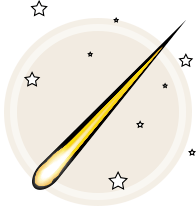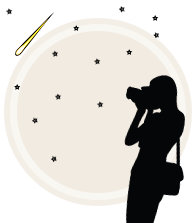Meteor activity kicks into high gear in August
as seen from the northern hemisphere. The main reason for this activity surge is
the Perseid shower that peaks on August 13. This shower is active most of the
month and remains above the level of the sporadic background for a week centered
on August 13. The sporadic activity is also increasing as seen from the northern
hemisphere and is now nearly double the rates from just three months ago. As
seen from south of the equator, meteor rates are still decent but falling
rapidly. The sporadic rates seen at the beginning of the month will be twice
as high as those seen during the last days of the month. The Perseid radiant
does not rise high into the sky as seen in the southern hemisphere so rates
from this shower are greatly reduced when compared to the northern hemisphere.
During this period the moon reaches its full
phase on Tuesday August 24th. At this time the moon will be located opposite the
sun and will be in the sky all night long. This weekend the waxing gibbous moon
will set near the start of morning twilight, depending on your latitude. The
further north one is located, the earlier the moon will set, allowing more time
to observe under dark skies. The estimated total hourly rates for
evening observers this week is near two no matter your location. For morning
observers the estimated total hourly rates should be near eight from the
northern hemisphere and six as seen from the southern hemisphere. The
actual rates will also depend on factors such as personal light and motion
perception, local weather conditions, alertness and experience in watching meteor
activity. Rates are reduced this week due to intense moonlight.
The radiant (the area of the sky where meteors appear
to shoot from) positions and rates listed below are exact for Saturday night/Sunday
morning August 21/22. These positions do not change greatly day to day so the listed
coordinates may be used during this entire period. Most star atlases (available at
science stores and planetariums) will provide maps with grid lines of the celestial
coordinates so that you may find out exactly where these positions are located in
the sky. A planisphere or computer planetarium program is also useful in showing
the sky at any time of night on any date of the year. Activity from each radiant
is best seen when it is positioned highest in the sky, either due north or south
along the meridian, depending on your latitude. It must be remembered that meteor
activity is rarely seen at the radiant position. Rather they shoot outwards from
the radiant so it is best to center your field of view so that the radiant lies
at the edge and not the center. Viewing there will allow you to easily trace the
path of each meteor back to the radiant (if it is a shower member) or in another
direction if it is a sporadic. Meteor activity is not seen from radiants that are
located below the horizon. The positions below are listed in a west to east
manner in order of right ascension (celestial longitude). The positions listed
first are located further west therefore are accessible earlier in the night while
those listed further down the list rise later in the night.
The table below presents a condensed version of the expected activity this week.
Rates and positions are exact for Saturday night/Sunday morning.
The detailed descriptions will be continued next week when the moonlight is not
as intense.
| SHOWER | DATE OF MAXIMUM ACTIVITY | CELESTIAL POSITION | ENTRY VELOCITY | CULMINATION | HOURLY RATE | CLASS* | RA (RA in Deg.) DEC | Km/Sec | Local Daylight Time | North-South | August Draconids (AUG) | Aug 21 | 18:28 (277) +63 | 23 | 22:00 | <1 - <1 | IV | Antihelion (ANT) | – | 22:48 (342) -06 | 30 | 02:00 | 1 – 1 | II | Delta Aquariids (SDA) | Jul 30 | 00:01 (000) -10 | 42 | 03:00 | <1 - <1 | I | Perseids (PER) | Aug 13 | 04:04 (061) +60 | 61 | 06:00 | 1 – <1 | I |




 You saw something bright and fast? Like a huge shooting star? Report it: it may be a fireball.
You saw something bright and fast? Like a huge shooting star? Report it: it may be a fireball.  You counted meteors last night? Share your results with us!
You counted meteors last night? Share your results with us!  You took a photo of a meteor or fireball? You have a screenshot of your cam? Share it with us!
You took a photo of a meteor or fireball? You have a screenshot of your cam? Share it with us!  You caught a meteor or fireball on video? Share your video with us!
You caught a meteor or fireball on video? Share your video with us!